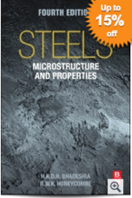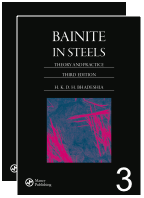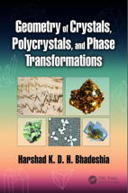
Synchrotron and neural network analysis of the influence of composition and heat treatment on the rolling contact fatigue of hypereutectoid pearlitic steels
W. Solano-Alvarez, M. Peet, E. J. Pickering and J. Jaiswal and A. Bevan and H. K. D. H. Bhadeshia
Abstract
A series of experimental hypereutectoid pearlitic steels were tested under rolling contact sliding conditions using a lubricated twin-disc setup to study the influence of different chemical compositions and heat treatments on rolling contact fatigue life. Tested samples were then characterised using microscopy and synchrotron measurements as a function of depth from the contact surface. Results, analysed through neural networks, indicate that the most influential factor in lengthening the number of cycles to crack initiation of hypereutectoid steels is hardness, attained by increasing the cooling rate from the hot rolling temperature, but adequate alloying additions can enhance it further. The harder, fast-cooled samples displayed less plastic flow at the surface than the softer slow-cooled ones. With regard to chemical composition, silicon was found to strengthen the ferrite thus reducing strain incompatibilities with the cementite, preventing in this way the fragmentation and eventual dissolution of the lamellae. This is beneficial since larger depths of cementite dissolution were found in samples with lower cycles to crack initiation for a given cooling rate (hardness). Samples containing vanadium lasted longer and displayed less plastic deformation at the surface than those without, at a similar hardness.
Materials Science & Engineering A 707 (2017) 259–269.
Download paper
Creative commons license

- "Steels for Rails"
Encyclopedia of Materials Science: Science and Technology, eds K. Buschow, R. W. Cahn, M. C. Flemings, B. Iischner, E. J. Kramer and S. Mahajan, Elsevier Science, ISBN 0-08-0431526, 2002, pp. 1-7.
H. K. D. H. Bhadeshia
- "Soft novel form of white-etching matter and ductile failure of carbide-free bainitic steels under rolling contact stresses"
Acta Materialia, 121 (2016) 215-226
W. Solano-Alvarez, E. J. Pickering, M. J. Peet, K. L. Moore, J. Jaiswal, A. Bevan and H. K. D. H. Bhadeshia
- "White-etching matter in bearing steel. Part 1: Controlled-cracking of bearing steel"
Metallurgical and Materials Transactions A 45 (2014) 4907-4915
W. Solano-Alvarez and H. K. D. H. Bhadeshia
- "White-etching matter in bearing steel: Part II: distinguishing cause and effect in bearing steel failure"
Metallurgical and Materials Transactions A 45 (2014) 4916-4931
W. Solano-Alvarez and H. K. D. H. Bhadeshia
- "Degradation of nanostructured bainitic steel under rolling contact fatigue"
Materials Science and Engineering A 617 (2014) 156-164.
W. Solano-Alvarez, E. J. Pickering and H. K. D. H. Bhadeshia
- "Role of stress-assisted martensite in the design of strong ultrafine-grained duplex steels"
Acta Materialia, 82, (2015) 100-114.
H. W. Yen, S. W. Ooi, M. Eizadjou, A. Breen, C. Y. Huang, H. K. D. H. Bhadeshia and S. P. Ringer
- "Phase quantification in nanobainite via magnetic measurements and X-ray diffraction"
Journal of Magnetism and Magnetic Materials 378 (2015) 200-205.
W. Solano-Alvarez, H. F. G. Abreu, M. R. da Silva and M. J. Peet





